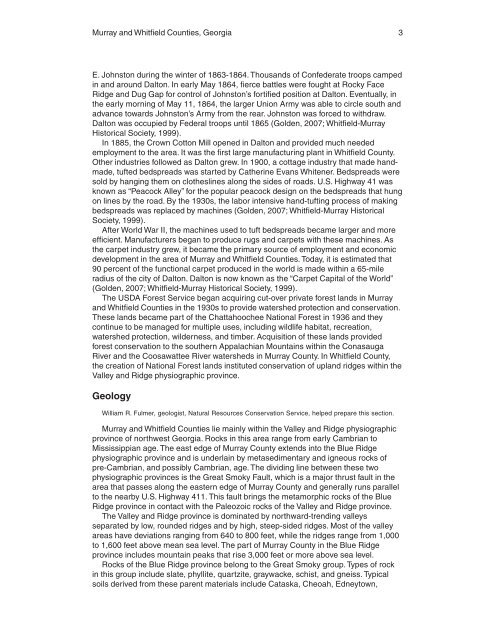Soil Survey of Murray and Whitfield Counties, Georgia
Soil Survey of Murray and Whitfield Counties, Georgia
Soil Survey of Murray and Whitfield Counties, Georgia
You also want an ePaper? Increase the reach of your titles
YUMPU automatically turns print PDFs into web optimized ePapers that Google loves.
<strong>Murray</strong> <strong>and</strong> <strong>Whitfield</strong> <strong>Counties</strong>, <strong>Georgia</strong> 3<br />
E. Johnston during the winter <strong>of</strong> 1863-1864. Thous<strong>and</strong>s <strong>of</strong> Confederate troops camped<br />
in <strong>and</strong> around Dalton. In early May 1864, fierce battles were fought at Rocky Face<br />
Ridge <strong>and</strong> Dug Gap for control <strong>of</strong> Johnston’s fortified position at Dalton. Eventually, in<br />
the early morning <strong>of</strong> May 11, 1864, the larger Union Army was able to circle south <strong>and</strong><br />
advance towards Johnston’s Army from the rear. Johnston was forced to withdraw.<br />
Dalton was occupied by Federal troops until 1865 (Golden, 2007; <strong>Whitfield</strong>-<strong>Murray</strong><br />
Historical Society, 1999).<br />
In 1885, the Crown Cotton Mill opened in Dalton <strong>and</strong> provided much needed<br />
employment to the area. It was the first large manufacturing plant in <strong>Whitfield</strong> County.<br />
Other industries followed as Dalton grew. In 1900, a cottage industry that made h<strong>and</strong>made,<br />
tufted bedspreads was started by Catherine Evans Whitener. Bedspreads were<br />
sold by hanging them on clotheslines along the sides <strong>of</strong> roads. U.S. Highway 41 was<br />
known as “Peacock Alley” for the popular peacock design on the bedspreads that hung<br />
on lines by the road. By the 1930s, the labor intensive h<strong>and</strong>-tufting process <strong>of</strong> making<br />
bedspreads was replaced by machines (Golden, 2007; <strong>Whitfield</strong>-<strong>Murray</strong> Historical<br />
Society, 1999).<br />
After World War II, the machines used to tuft bedspreads became larger <strong>and</strong> more<br />
efficient. Manufacturers began to produce rugs <strong>and</strong> carpets with these machines. As<br />
the carpet industry grew, it became the primary source <strong>of</strong> employment <strong>and</strong> economic<br />
development in the area <strong>of</strong> <strong>Murray</strong> <strong>and</strong> <strong>Whitfield</strong> <strong>Counties</strong>. Today, it is estimated that<br />
90 percent <strong>of</strong> the functional carpet produced in the world is made within a 65-mile<br />
radius <strong>of</strong> the city <strong>of</strong> Dalton. Dalton is now known as the “Carpet Capital <strong>of</strong> the World”<br />
(Golden, 2007; <strong>Whitfield</strong>-<strong>Murray</strong> Historical Society, 1999).<br />
The USDA Forest Service began acquiring cut-over private forest l<strong>and</strong>s in <strong>Murray</strong><br />
<strong>and</strong> <strong>Whitfield</strong> <strong>Counties</strong> in the 1930s to provide watershed protection <strong>and</strong> conservation.<br />
These l<strong>and</strong>s became part <strong>of</strong> the Chattahoochee National Forest in 1936 <strong>and</strong> they<br />
continue to be managed for multiple uses, including wildlife habitat, recreation,<br />
watershed protection, wilderness, <strong>and</strong> timber. Acquisition <strong>of</strong> these l<strong>and</strong>s provided<br />
forest conservation to the southern Appalachian Mountains within the Conasauga<br />
River <strong>and</strong> the Coosawattee River watersheds in <strong>Murray</strong> County. In <strong>Whitfield</strong> County,<br />
the creation <strong>of</strong> National Forest l<strong>and</strong>s instituted conservation <strong>of</strong> upl<strong>and</strong> ridges within the<br />
Valley <strong>and</strong> Ridge physiographic province.<br />
Geology<br />
William R. Fulmer, geologist, Natural Resources Conservation Service, helped prepare this section.<br />
<strong>Murray</strong> <strong>and</strong> <strong>Whitfield</strong> <strong>Counties</strong> lie mainly within the Valley <strong>and</strong> Ridge physiographic<br />
province <strong>of</strong> northwest <strong>Georgia</strong>. Rocks in this area range from early Cambrian to<br />
Mississippian age. The east edge <strong>of</strong> <strong>Murray</strong> County extends into the Blue Ridge<br />
physiographic province <strong>and</strong> is underlain by metasedimentary <strong>and</strong> igneous rocks <strong>of</strong><br />
pre-Cambrian, <strong>and</strong> possibly Cambrian, age. The dividing line between these two<br />
physiographic provinces is the Great Smoky Fault, which is a major thrust fault in the<br />
area that passes along the eastern edge <strong>of</strong> <strong>Murray</strong> County <strong>and</strong> generally runs parallel<br />
to the nearby U.S. Highway 411. This fault brings the metamorphic rocks <strong>of</strong> the Blue<br />
Ridge province in contact with the Paleozoic rocks <strong>of</strong> the Valley <strong>and</strong> Ridge province.<br />
The Valley <strong>and</strong> Ridge province is dominated by northward-trending valleys<br />
separated by low, rounded ridges <strong>and</strong> by high, steep-sided ridges. Most <strong>of</strong> the valley<br />
areas have deviations ranging from 640 to 800 feet, while the ridges range from 1,000<br />
to 1,600 feet above mean sea level. The part <strong>of</strong> <strong>Murray</strong> County in the Blue Ridge<br />
province includes mountain peaks that rise 3,000 feet or more above sea level.<br />
Rocks <strong>of</strong> the Blue Ridge province belong to the Great Smoky group. Types <strong>of</strong> rock<br />
in this group include slate, phyllite, quartzite, graywacke, schist, <strong>and</strong> gneiss. Typical<br />
soils derived from these parent materials include Cataska, Cheoah, Edneytown,
















